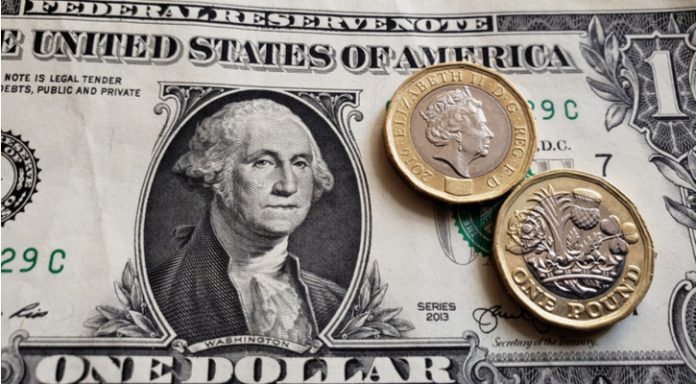The pound dropped lower versus the strong US dollar on Monday. The pound US dollar exchange rate declined to a nadir of US$1.2400, as investors sought the safety of the dollar and as Brexit talks went nowhere quickly. The pair closed the session down 0.5% at US$1.2426 and is edging lower in early trade on Tuesday.
| What do these figures mean? |
| When measuring the value of a pair of currencies, one set equals 1 unit and the other shows the current equivalent. As the market moves, the amount will vary from minute to minute.
For example, it could be written: 1 GBP = 1.28934 USD Here, £1 is equivalent to approximately $1.29. This specifically measures the pound’s worth against the dollar. If the US dollar amount increases in this pairing, it’s positive for the pound. Or, if you were looking at it the other way around: 1 USD = 0.77786 GBP In this example, $1 is equivalent to approximately £0.78. This measures the US dollar’s worth versus the British pound. If the sterling number gets larger, it’s good news for the dollar. |
UK Prime Minister Boris Johnson met with the President of the European Commission Jean — Claude Juncker and with his counterpart the Prime Minister of Luxembourg. However, headlines suggest little progress is being made in UK — EU Brexit negotiations.
The EU insist that they are still waiting for a comprehensive alternative to the Irish backstop. The EU criticised the UK’s level of depth and detail on the matter. UK Foreign Minister Dominic Raab threw plenty of criticism back and reiterated the UK will leave EU on 31st October. Yesterday’s events raised concerns, once again, of a no deal Brexit, the pound dropped.
| Why is a “soft” Brexit better for sterling than a “hard” Brexit? |
| A soft Brexit implies anything less than UK’s complete withdrawal from the EU. For example, it could mean the UK retains some form of membership to the European Union single market in exchange for some free movement of people, i.e. immigration. This is considered more positive than a “hard” Brexit, which is a full severance from the EU. The reason “soft” is considered more pound-friendly is because the economic impact would be lower. If there is less negative impact on the economy, foreign investors will continue to invest in the UK. As investment requires local currency, this increased demand for the pound then boosts its value. |
Today attention will remain on Brexit as Boris Johnson’s decision to suspend Parliament enters the UK Supreme Court. There will be a three-day hearing on whether the PM’ proroguing of Parliament is illegal.
Will US Manufacturing Sector Show Further Weakness Hitting Dollar?
The US dollar was in favour in the previous session as investors brought into its safe haven status. As the reserve currency of the world, the dollar tends to appreciate when geopolitical tensions increase. Attacks over the weekend on Saudi oil infrastructure, and comments by President Tump that the US were “locked and loaded” elevated geopolitical tensions. Should evidence point to Iran being involved, tensions could rise further.
Investors will be watching carefully as to how the situation in the middle east develops. A further escalation in tensions between US and Iran could lift the dollar further.
Today industrial production and manufacturing data will also be under the spotlight. Industrial output fell in July and the manufacturing sector continued to struggle with trade related headwinds. Market participants will continue to look for signs of a deepening slowdown in the manufacturing sector. The data comes the day before the Federal Reserve will gives its monetary policy announcement. Analysts widely believe the Fed will cut rates.
| Why do interest rate cuts drag on a currency’s value? |
| Interest rates are key to understanding exchange rate movements. Those who have large sums of money to invest want the highest return on their investments. Lower interest rate environments tend to offer lower yields. So, if the interest rate or at least the interest rate expectation of a country is relatively lower compared to another, then foreign investors look to pull their capital out and invest elsewhere. Large corporations and investors sell out of local currency to invest elsewhere. More local currency is available as the demand of that currency declines, dragging the value lower. |





